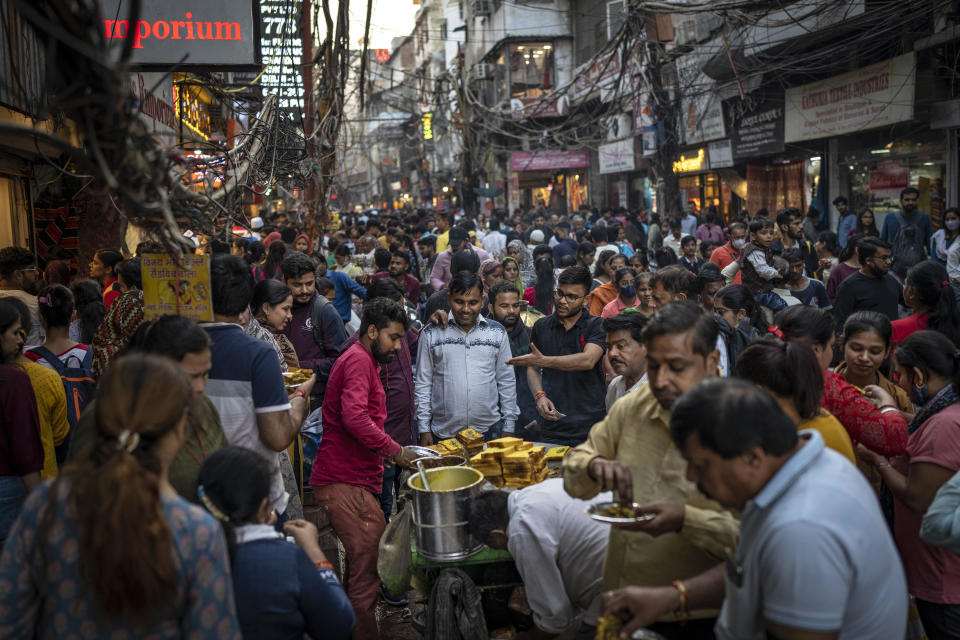India's population set to surpass China's in summer 2023, U.N. says
New Delhi — India is on track to surpass China as the country with the largest population in the world by summer 2023, according to a new estimate by the United Nations. Data projections show India will have a population of 1.4286 billion by the middle of this year — about 2.9 million more than China, according to the U.N. Population Fund's (UNFPA) "State of World Population Report," which was released Wednesday.
China's population will stand at 1.4257 billion this summer, according to the report.
India's population is expected to continue growing for the next three decades as China's decreases, widening the gap between the two most populous nations. The U.N.'s World Population Prospects report, released in July last year, projected that India's population will peak in 2050 at 1.668 billion, far exceeding China's, which the report said would likely sit around 1.3 billion in that year.
In 1950, India was home to some 861 million people, while China had a population of 1.144 billion, highlighting how rapidly India has grown over the last seven decades.
China has slowly slid down population ranking charts due to declining birth rates and a rapidly aging population. India, on the other hand, has a relatively young population, with almost 25% of the country's population estimated to be under the age of 14, while 68% are between 15 and 64. Only 7% of the population is believed to be 65 or older, U.N. data show.
"I think the big story for India is how they will effectively and quickly invest in what's required to gain a demographic dividend," Rachel Snow, the United Nations Population Fund's (UNFPA) lead demographer, told CBS News correspondent Pamela Falk. "You've got this big bulge of young people entering both reproductive years, which means fertility will keep growing, but [also] entering the age of life for working."
The U.N. data is an estimate. India has not conducted a national census since 2011, and the census scheduled for 2021 was delayed due to the coronavirus pandemic.
The U.N. report also estimated that the global population would hit 8.045 billion by mid-2023. The U.S. is expected to have a population of 340 million people by this summer, leaving it the world's 3rd most populous nation – albeit with a fraction of the inhabitants of either India or China.
India's "population anxieties" and opportunities
A public survey done by UNFPA for its 2023 report found the most commonly held opinion in India was that the population "was too large and fertility rates were too high," the report said.
"The Indian survey findings suggest that population anxieties have seeped into large portions of the general public," Andrea Wojnar, the agency's India representative, said in a statement.
That anxiety appears to focus largely on how India will be able to meet the challenges presented by such a large population: from food security to economic growth, employment, education and health care.

While India has rebounded to become one of the fastest-growing economies in the world in the wake of the COVID pandemic, recently overtaking its former colonizing power the U.K. to become the world's fifth-largest economy, economists consistently note the growing gap between India's richest and poorest inhabitants — the unequal nature of its development — as a cause for concern.
India's richest 1% held more than 40.5% of the country's overall wealth in 2021, according to an Oxfam report. Last year, the number of billionaires in India jumped to 166, from 102 in 2020, the report said.
There's also unease over the large gulf between pay for men and women in India's workforce, and the low number of women at work in general, even compared to China.
Snow, of the UNFPA, told CBS News the challenge for India as it sits in its "window of possibility" with such a vital, young population will be to "mobilize the necessary investments in education and job creation in gender equality, so that there will be an opportunity for that large population to indeed yield a dividend for the economy."
"Governments must create policies with gender equality and rights at their heart, such as parental leave programmes, child tax credits, policies that promote gender equality in the workplace, and universal access to sexual and reproductive health," said Poonam Muttreja, the Executive Director of the Population Foundation of India, in a statement.
Having such a vast and growing population brings with it, in other words, an equally vast litany of opportunities and challenges. Over the coming decades, India's challenge will be to harness the human resources at its disposal to grow its economy not just for the few, but for the very, very many.
Exclusive discounts from CBS Mornings Deals
BeyGOOD's Ivy McGregor on how Beyoncé's Renaissance tour supports education and entrepreneurs

